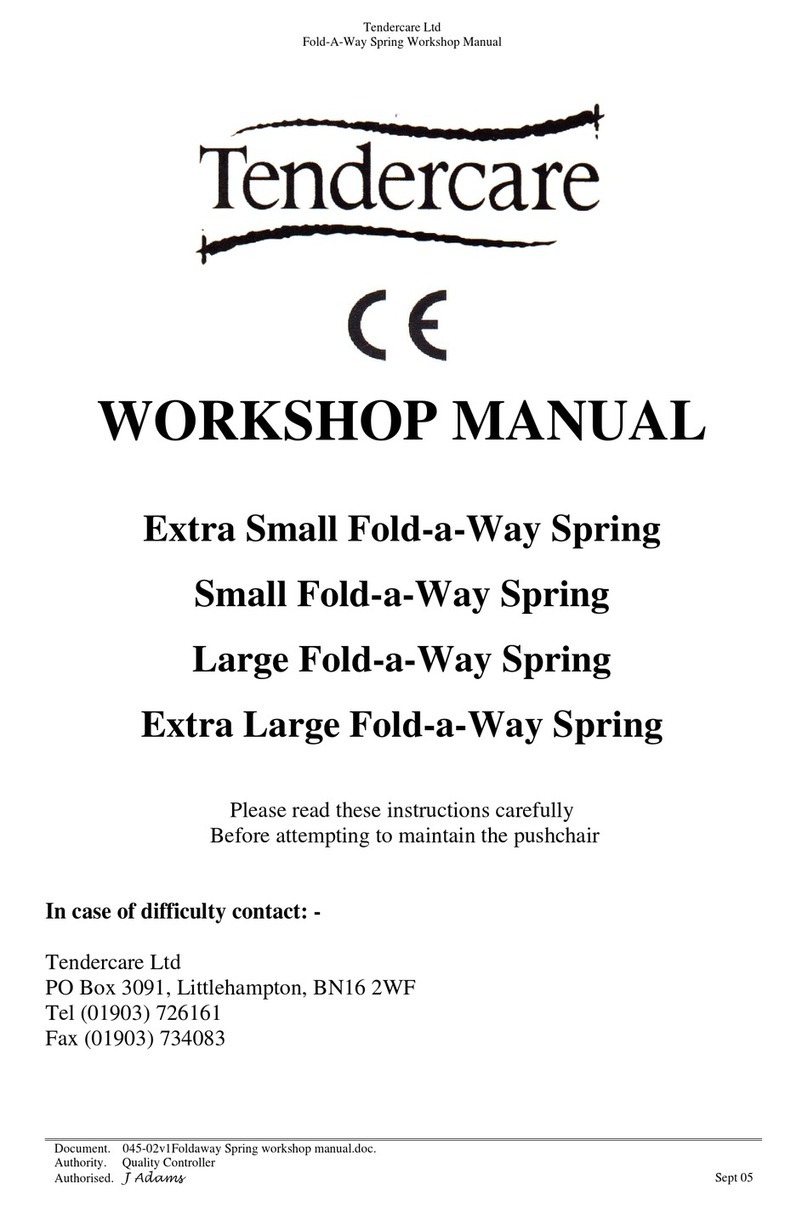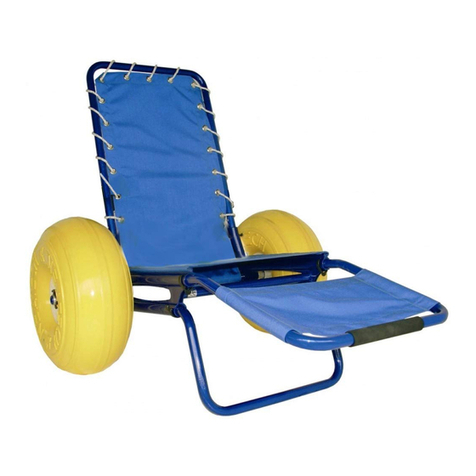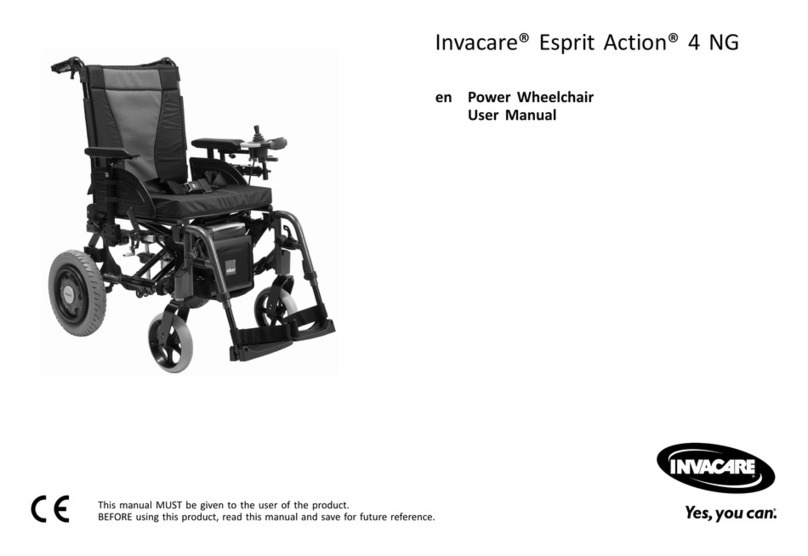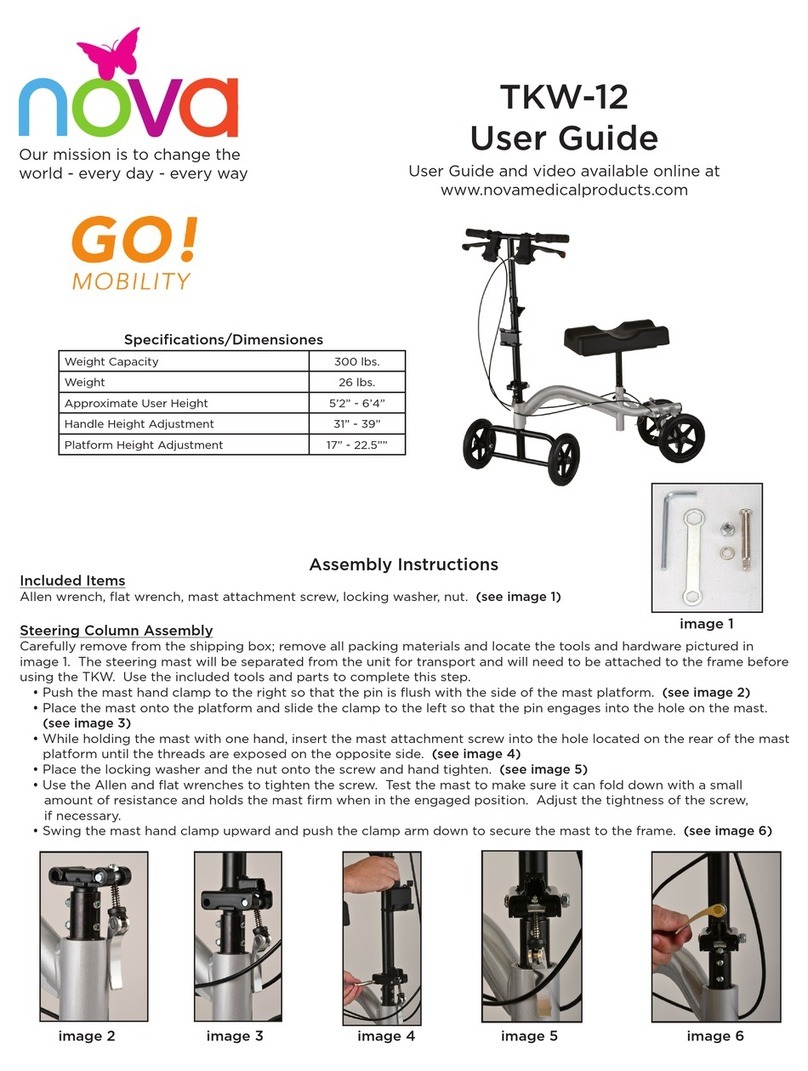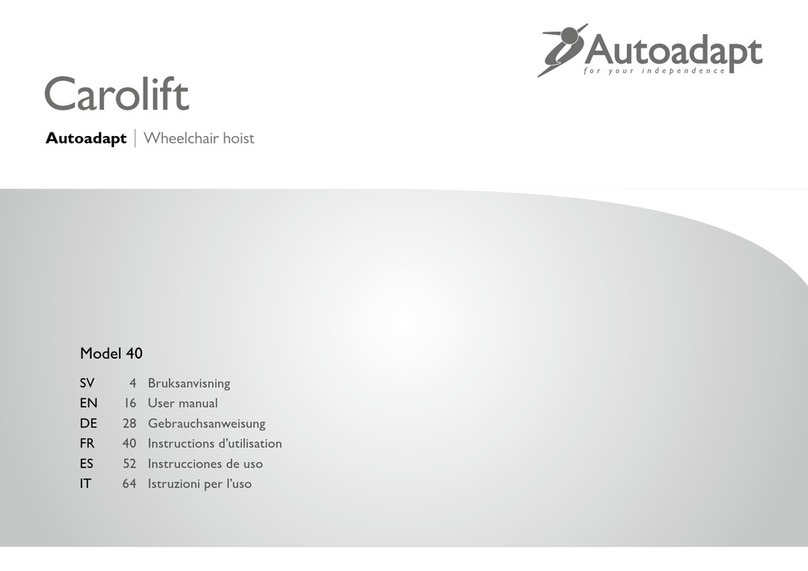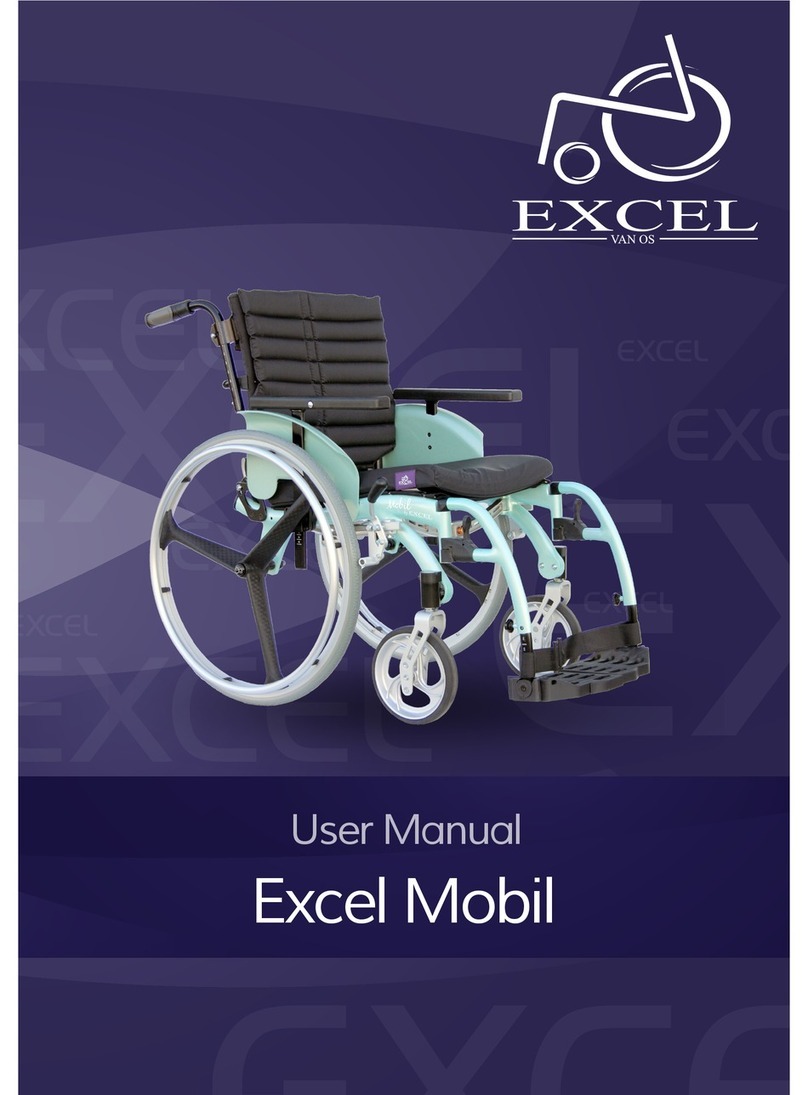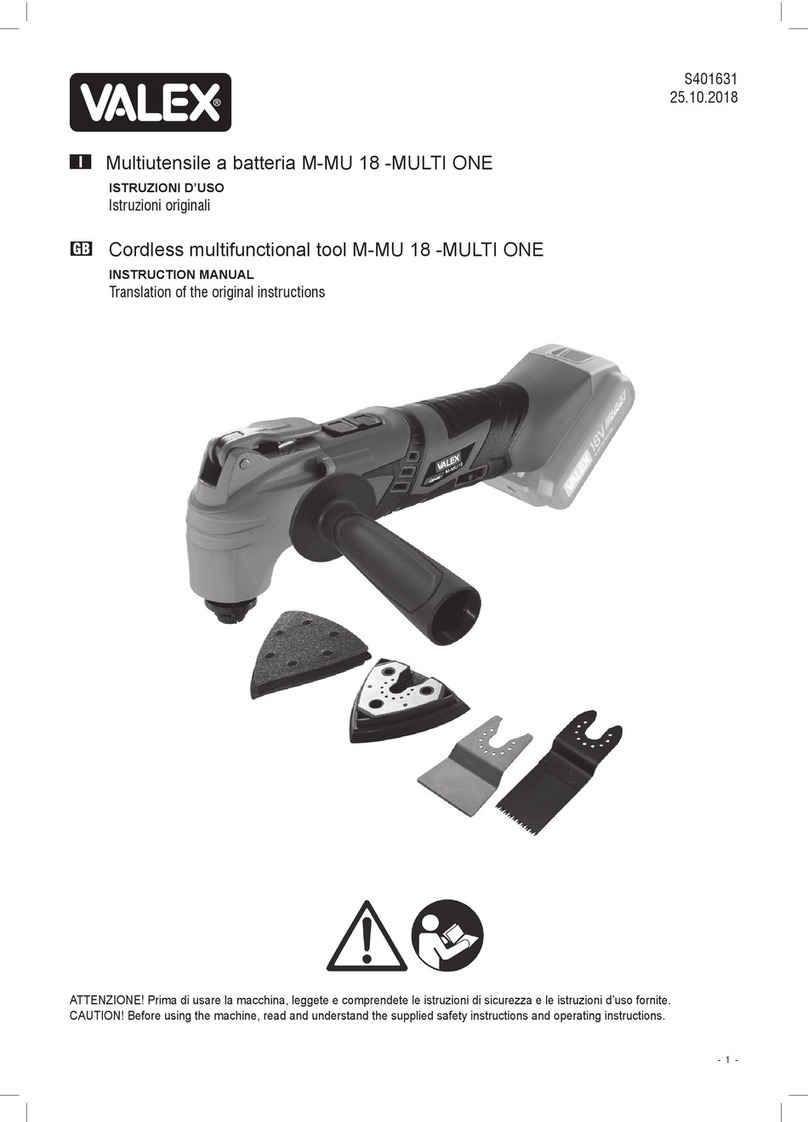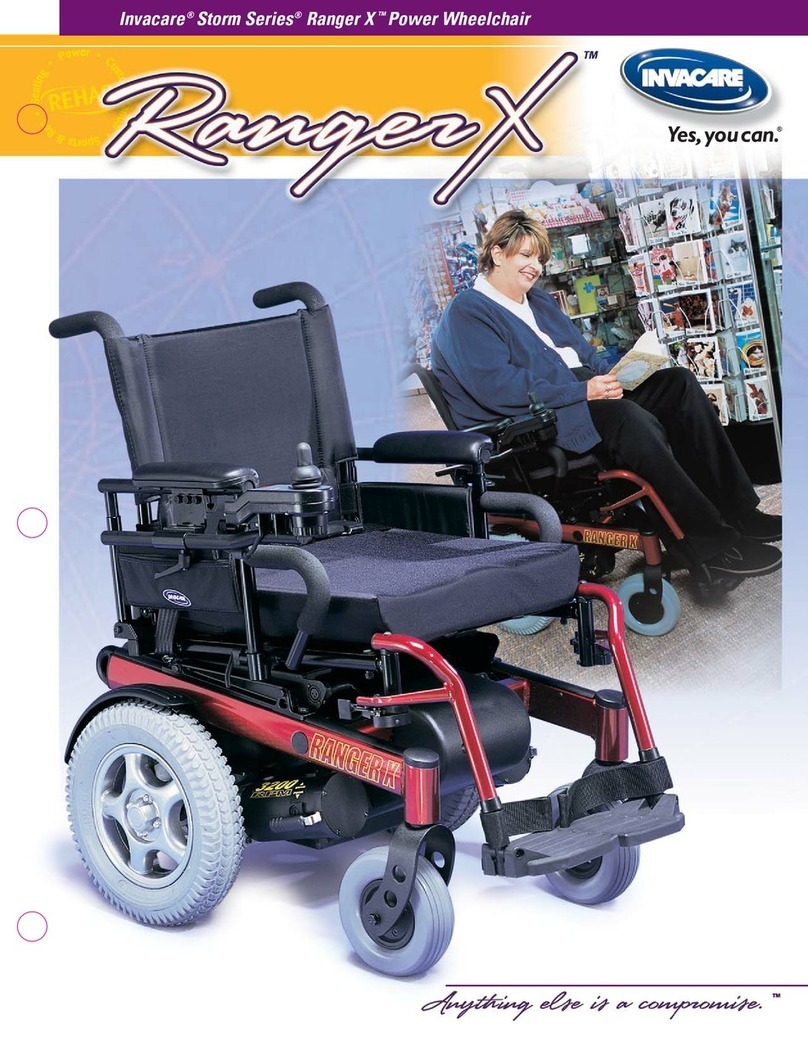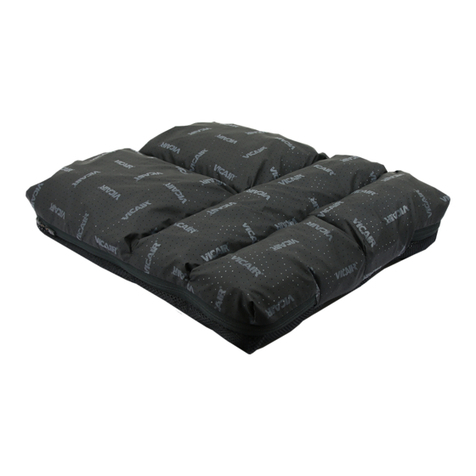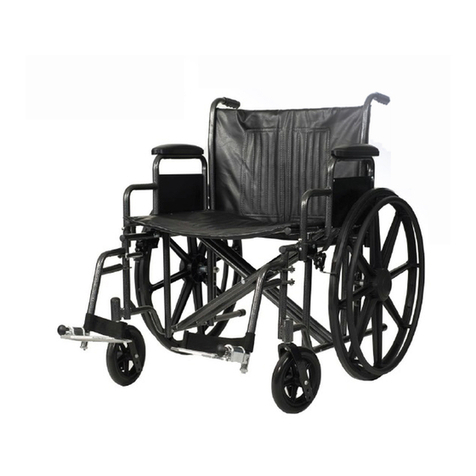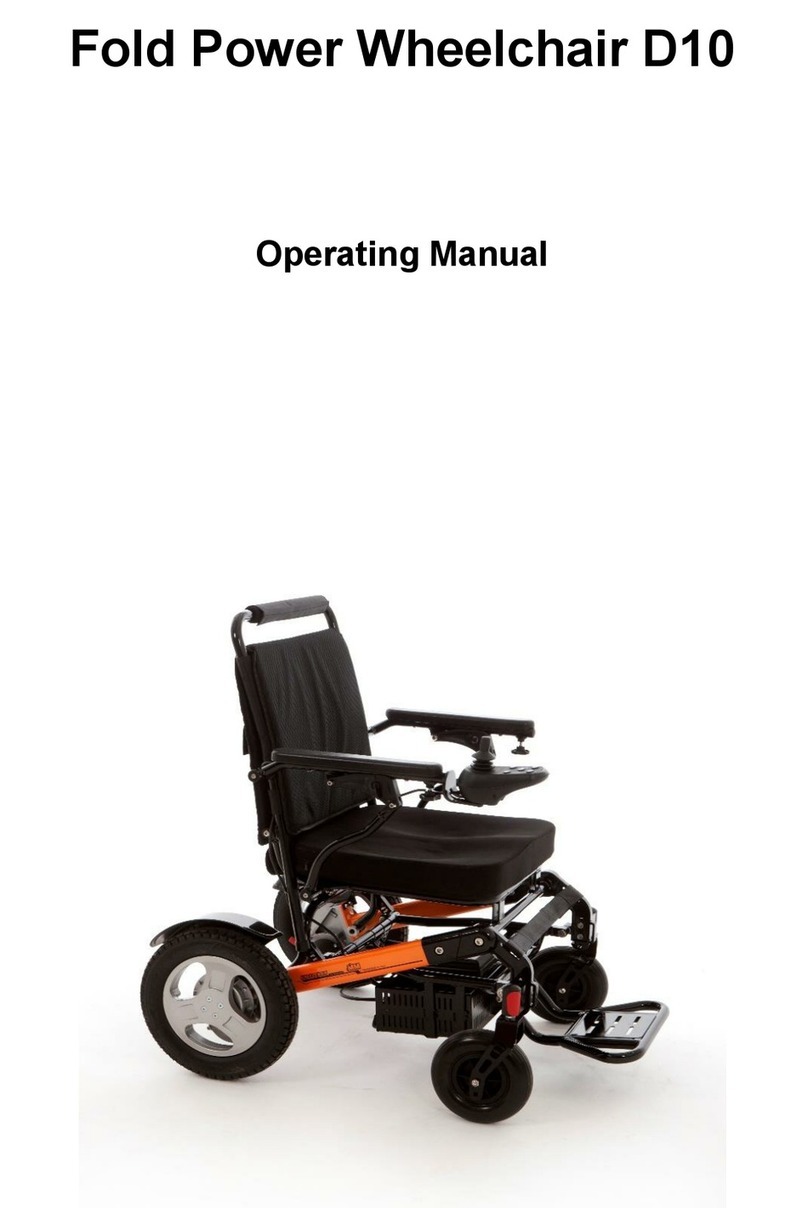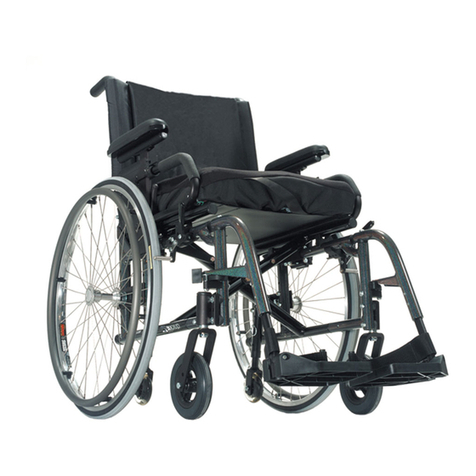Tendercare Mini Tilt Wheelchair Instruction manual

Mini Tilt Wheelchair
Document No: 054-02 v6 Page 1 of 37 January 2014
New Mini Tilt Workshop Manual.doc
Mini Tilt Wheelchair
Workshop Manual
IMPORTANT
Please read these instructions carefully
before using the wheelchair

Mini Tilt Wheelchair
Document No: 054-02 v6 Page 2 of 37 January 2014
New Mini Tilt Workshop Manual.doc
Fig 0.1: 14” Mini Tilt with standard accessories (partial tilt)
Fig 0.2: 14” Mini Tilt folded for transport
Half Height
Back Canvas
Armrest
Push
Handle
Tilt
Lever
Attendant
Brake
Handle
Clamping
Lever
Full Seat
Canvas
Backrest
Lock

Mini Tilt Wheelchair
Document No: 054-02 v6 Page 3 of 37 January 2014
New Mini Tilt Workshop Manual.doc
Item
Description
Page
1
Your Aluminium Mini Tilt Wheelchair Manual
4
1.1: Size and weight
4 – 5
2
Transit Packaging
6
3
Tools and torque settings
6
4
Preparing the wheelchair for use
7
4.1 Unfold and lock the backrest
7
4.2 Adjust the push handles
7
4.3 Fit and adjust the armrests
7
4.4 Footrests (optional
8
4.5 Tilt in Space
8
4.6 Tyres and brakes
8
4.7 Rear wheel position
8 – 11
4.8 Hub Brake Wheels Fitting Instructions
11 - 19
5 Cleaning 20
6 Maintenance 20
6.1 Routine maintenance 20
6.2 Six-monthly maintenance 20 – 21
7 Repairs 21
7.1 Front Castors 21
7.2 Rear Wheels 21 – 22
7.3 Brake Adjustment 22 – 23
7.4 Replacing Arm Pads 23
7.5 Replacing Seat Upholstery 23
7.6 Replacing Backrest Upholstery 24
7.7 Replace The Gas Strut 24 – 26
7.8 Replace The Operating Lever and Cable 26
7.9 Push handle and safety cable replacement 26 – 31
7.10 Push handle and safety bush replacement (new style handle) 32 – 35
8 Important Points 36
9 Dimensions and Technical Information 36 – 37
10 Parts List 37

Mini Tilt Wheelchair
Document No: 054-02 v6 Page 4 of 37 January 2014
New Mini Tilt Workshop Manual.doc
1: Mini Tilt Wheelchair Manual
The purpose of this manual is to help you get the best from your wheelchair. It does this by
telling you how to complete those maintenance tasks that can be carried out by a
competent person. The manual also tells you when you should contact the manufacturer
who is:
Tendercare Ltd.
PO BOX 3091, Littlehampton, BN16 2WF
Tel: (01903) 726161 Fax: (01903) 734083
Email: [email protected]
Web: www.tendercareltd.com
IMPORTANT:
This manual must be read and used in conjunction with the user manual.
This product benefits from a tilt in space facility and has been designed for use as a
wheelchair or wheelbase for use with special seating systems. It is available in three seat
widths 305mm (12”), 356mm (14”) and 406mm (16”). These instructions apply to all sizes.
The wheelchair has 2 fixed rear wheels and 2 front castor wheels for easy steering. The
backrest can be folded for transit. The armrests lift off for easy side transfer and the push
handles are adjustable in height and angle to suit a wide range of attendants.
The maximum carrying weight is to include occupant, seating systems and all accessories
and should not exceed 57Kg (9 stone).
1.1: Size and weight:
All sizes and weights are given as a guide. Tendercare ltd reserves the right to amend
specifications at any time as part of their product development programme.
Weight*:
12”: 16 kg
14”: 16.8 kg
16”: 17.6 kg
*Weight includes complete frame and the following standard accessories: Armrests, half
height canvas set, attendant brakes and push handles.

Mini Tilt Wheelchair
Document No: 054-02 v6 Page 5 of 37 January 2014
New Mini Tilt Workshop Manual.doc
Dimensions (mm)
Mini Tilt Open (no tilt)
12” 14” 16”
A 670 670 715
B 500 550 565
C 1050 1050 1050
Dimensions (mm)
Mini Tilt Folded
12” 14” 16”
A 860 860 860
B 500 550 565
C 590 590 590

Mini Tilt Wheelchair
Document No: 054-02 v6 Page 6 of 37 January 2014
New Mini Tilt Workshop Manual.doc
2: Transit Packaging
The wheelchair is delivered in a cardboard carton approximate weight 20 kg and size
630mm wide x 595mm deep x 890mm high.
Warning the transit carton is heavy so moving and unpacking must be done with
care. Observe all lifting and handling regulations.
1. Stand the carton upright making sure it is supported and cannot fall over. Open the
carton and remove any packages or packing, which could obstruct the removal of
the frame.
2. Carefully pull out the wheelchair and check that you have the following items:
Item Component QTY. Yes No
1 Mini Tilt Wheelchair 1
2 Armrests 2
3 User Manual 1
IMPORTANT:
If any items are damaged or missing, then please contact Tendercare, preferably by
within 36 hours of delivery.
After unpacking and checking you have all components and they are in good condition
dispose of the packaging at your local recycling centre. Alternatively retain and reuse.
3: Tools and torque settings
The following tools are required to dismantle and reassembly the wheelchair:
Spanners and sockets: 8mm, 10mm, 13mm, 2 x 19mm and 24mm
Hexagon keys: 3mm, 4mm and 5mm
Torque wrench: Range 0 to 60 Nm
Screwdriver: 1 Small flat blade and 1 medium Philips screwdriver.
Torque Settings:
Spanner Size (mm)
Torque (Nm)
8 10
10 15
13 25
19 45
24 54

Mini Tilt Wheelchair
Document No: 054-02 v6 Page 7 of 37 January 2014
New Mini Tilt Workshop Manual.doc
4: Preparing the wheelchair for use
Warning: When assembling the wheelchair for use, ensure that you hold the frame
so that you avoid any danger of catching your fingers in moving parts.
The following pre-delivery procedures should be carried out to check that the wheelchair
has not suffered damage during transit and that all features operate satisfactorily. Refer to
the user manual for detailed instructions on performing each action.
4.1: Unfold and lock the backrest:
Follow the instructions laid out in section 4.1 of the user manual.
Check that:
•The locks operate positively and freely
•Make sure the back hinge joints move freely
•Ensure that all fixings are secure and the frame has not been bent or otherwise
damaged during transit.
4.2: Adjust the push handles:
Follow the instructions in section 4.2 of the user manual.
Check that:
•The handles adjust freely
•That the handles are secure and cannot move when locked
•That the handles cannot be removed from the frame when unlocked
4.3: Fit and adjust the armrests:
Follow the instructions in section 4.3 of the user manual
Check that:
•The flick catch works correctly and that the armrest can be adjusted / removed
•That the armrests are secure when tightened
•Check that the armrest pads and framework have not been bent or otherwise
damaged during transit

Mini Tilt Wheelchair
Document No: 054-02 v6 Page 8 of 37 January 2014
New Mini Tilt Workshop Manual.doc
4.4: Footrests (optional):
If footrests are fitted to the chair, follow the instructions on section 4.4 of the user manual
and check the following:
•That the depth adjustment moves smoothly and locks correctly
•The height adjustment works correctly and locks securely
•That the footplate will remain in the vertical position when lifted
•Check the footrests and brackets for transit damage
4.5 Tilt in Space:
The angle of the seat and backrest can be adjusted to any angle between upright and fully
reclined. Test the tilt mechanism by following the instructions in section 4.5 of the user
manual.
Important: Always put the brakes on and move both push handles together when
adjust the seat angle.
Things to check:
•Check that the tilt adjusts smoothly through the full range of motion of the gas
spring
•Check that the tilt in space mechanism locks when the tilt lever is released
4.6 Tyres and brakes:
The tyres are made from a solid material and do not require any attention other than being
cleaned with a damp cloth when dirty.
Check the brakes by moving both levers forward as far as they will go. The wheels should
now be locked. If the wheels move the brakes need adjusting (see section 7.3 for details
on how to adjust the brake).
To avoid making flat sections on the tyre, never leave the brakes on for long periods i.e.
overnight or during storage.
4.7 Rear wheel position:
The rear wheels are supplied mounted in the forward position to provide optimum ease of
manoeuvring and tipping. However, a small number of people may require a greater
degree of stability. If this is the case the rear wheels and brakes can be moved to the rear
mounting position. Only someone who is a competent tradesman or repairer should carry
out this procedure.
There are 2 different brake systems used on the Mini Tilt. For wheelchairs purchased
before 16/06/2010 please follow the ‘old style brake’ instructions. For wheelchairs
purchased after this date please follow the ‘new style brake’ instructions.

Mini Tilt Wheelchair
Document No: 054-02 v6 Page 9 of 37 January 2014
New Mini Tilt Workshop Manual.doc
Old style brake:
To move the rear wheel position:
Using two 19mm spanners undo the axle-
mounting nut (see Fig 4.7.1, right). Make
sure you note the position of the washer
and spacer bushing. Reassemble in the
rear position, apply loctite to the threads
and tighten the nut.
Fig 4.7.1
Fig 4.7.2
To move the brake assembly, use a 3mm
hexagon key and 8mm spanner to remove
the rear brake linkage screw (see fig 4.7.2,
left)making a note of the position of the
spacers (see fig 4.7.3, below)
Fig 4.7.3
Using a 4mm hexagon key and 10mm spanner, remove the two back plate retaining
screws, tube support bushings and brake spacer taking note of the position of the locknut
and washers. Remove the caps from the 3
rd
mounting hole using a small flat bladed
screwdriver, then refit the screws making sure that the tube support bushing is placed
through the tube, and the brake spacer is correctly positioned (see fig 4.7.4 & 4.7.5 on
page 10).

Mini Tilt Wheelchair
Document No: 054-02 v6 Page 10 of 37 January 2014
New Mini Tilt Workshop Manual.doc
Fig 4.7.4
Fig 4.7.5
Once complete, refit the caps into the open hole (these simply push into place), and
reassemble the rear brake linkage.
Finally adjust the brakes as described in section 7.3.
New Style Brake:
To move the rear wheel position:
Using two 19mm spanners undo the axle-
mounting nut (see fig 4.7.6, right). Make
sure you note the position of the washer
and spacer bushing. Reassemble in the
rear position, apply loctite to the threads
and tighten the nut.
Fig 4.7.6
Fig 4.7.7
Next, loosen the 2 locking bolts in the
brake clamp using a 6mm hexagon key
(see fig 4.7.7, left) to the point where the
brake will move when pressure is applied
but will hold its position.
Slide the brake down the frame tube
towards the rear wheel.

Mini Tilt Wheelchair
Document No: 054-02 v6 Page 11 of 37 January 2014
New Mini Tilt Workshop Manual.doc
Ensuring that the brake is set fully in the
‘off’ position, place the 6mm hexagon key
against the tyre of the rear wheel and slide
the brake forward until it touches the other
side of the hexagon key (see fig 4.7.8,
right). This ensures that there will be
sufficient engagement with the tyre when
the brake is ‘on’ without making it too
difficult to operate.
Fig 4.7.8
Fig 4.7.9
Tighten the brake mounting using the
hexagon key until it is secure (the clamp
will need to be tight to achieve this!).
Test the brake to make sure it locks the
rear wheel. If the lock isn’t sufficient,
loosen the brake and slide closer to the
rear tyre, tighten and re test.
4.8: Hub Brake Wheels Fitting Instructions
Please note this procedure should only be carried out by a competent tradesperson, and
requires a number of specialist workshop tools. If you do not have access to the required
equipment or do not feel confident in carrying out this procedure, please return the
wheelchair to Tendercare where the wheels can be fitted in the factory and returned
(charges may apply).

Mini Tilt Wheelchair
Document No: 054-02 v6 Page 12 of 37 January 2014
New Mini Tilt Workshop Manual.doc
Fig 1
Parts Supplied:
A. 1 x Left Hand Hub Brake Wheel + Nut
B. 1 x Right Hand Hub Brake Wheel + Nut
C. 1 x Brake Lever, clamp, locking bolt, washer, 1 plain nut and 1 nylock dome
nut
D. 1 x Rubber packing piece
E. 2 x Cable Guides
F. 2 x Cable Locks + Washers + Nuts
G. 2 x Brake Cables
H. 5 x Cable Ties (3 shown)
I. 2 x M6 Sheet Nuts
J. 2 x Spacer Bushes
K. 2 x M6 x 40mm Socket Button Screws
L. 2 x M6 Form A Washers
M. 2 x End Crimp Fittings (Not Shown)
Tools Required:
N. 2 x 19mm Spanners
O. 1 x 6mm Drill Bit
P. 1 x 9mm Drill Bit
Q. 1 x 8mm Spanner (Not Shown)
R. 1 x 4mm Hexagon Key (Not Shown)
S. 1 x De-burring Tool (Not Shown)
T. 1 x Cordless Drill (Not Shown)
U. 1 x Sheet Nut Fitting Tool (Not Shown)
A
B
C
D
E
F
G
H
I
J
K
L
N
O
P

Mini Tilt Wheelchair
Document No: 054-02 v6 Page 13 of 37 January 2014
New Mini Tilt Workshop Manual.doc
Fig 4.8.2
Section I: Brake Lever and Cables
I.1
First, set up the wheelchair on a flat
workbench.
Take the rubber packing strip (D), and fit
to the left hand push-handle (looking
from the back of the wheelchair) as
shown (see Fig 2, left). It may be easier
to hold the strip in place with some
double sided tape or super glue.
I.2
Next fit the brake lever (C) to the left
push handle around the rubber spacer
using the included clamp. Lock the clamp
onto the handle using the bolt, washer
and plain nut (see Fig 3, right). Once
tight, secure using the nylock dome nut
(this will prevent the clamp becoming
loose over time).
Fig 4.8.3
Fig 4.8.4
I.3
Take the brake cables (G), cut off the
‘barrel’ end cap on each cable as shown
in Fig 4, left (leave the cylindrical end
stops on the other end of the cables in
place).
Next, slide the plastic outer cable off of
the inner wire.

Mini Tilt Wheelchair
Document No: 054-02 v6 Page 14 of 37 January 2014
New Mini Tilt Workshop Manual.doc
I.4
Feed the inner cables through the
mounting point in the lever and the cable
guide as shown in Fig 3, right (both
cables mount to the same handle, one
each side).
Fig 4.8.5
Fig 4.8.6
I.5
Pull the cable through until the end stop
pulls into the mounting point in the
handle as shown (see Fig 6, left).
I.6
Re-attach the plastic outer cables; slide
all the way until the end of the plastic
cable locates into the fixing point in the
brake lever as shown (see Fig 7, right).
Loop the free end of the cables under the
wheelchair base frame to keep them out
of the way.
Fig 4.8.7

Mini Tilt Wheelchair
Document No: 054-02 v6 Page 15 of 37 January 2014
New Mini Tilt Workshop Manual.doc
Fig 4.8.8
Section II: Hub Brake Wheels
II.1
Remove the left hand rear wheel using
the 19mm spanners (for details of this
procedure please refer to the workshop
manual).
Replace with the left hand hub brake
wheel (the holes on the metal place on
the hub brake should face the front of the
frame, see Fig 9 below).
II.2
Line up the middle hole in the metal
plate, with the centre of the lower rear
frame tube on the wheelchair as shown
(see Fig 9, right).
Fig 4.8.9
Fig 4.8.10
II.3
Using a cordless drill and the 6mm drill
bit, mark off the position of the hole on
the frame, taking care to ensure the drill
is straight (see Fig 10, left).

Mini Tilt Wheelchair
Document No: 054-02 v6 Page 16 of 37 January 2014
New Mini Tilt Workshop Manual.doc
II.4
Remove the hub brake wheel (it may
help to prop up the side without a wheel
onto a small box for support). Centre
punch the hole positioned as marked in
the previous step, and then drill first
using the 6mm drill, then open out with
the 9mm drill as shown (see Fig 11,
right). Please note, only drill through one
side of the tube. After drilling debur using
a deburring tool or a large drill bit.
Fig 4.8.11
Fig 4.8.12
II.5
Place one of the M6 sheet nuts into the
hole, and secure in place using a sheet
nut fitting tool (see Fig 12, left).
Repeat steps 2.1 to 2.5 for the right hand
hub brake wheel.
II.6
Fit the hub brake wheels onto the frame
using the round bushes and locking
washers removed from the original
wheels, and tighten using the new nuts
supplied with the wheels.
Line up the middle hole in the hub brake
wheel metal plate with the sheet nut fitted
to the base frame. Place a spacer (J) and
an M6 washer (L) in between the hole in
the plate and the sheet nut, and secure
by putting an M6 x 40mm bolt (K)
through the plate, washer and spacer,
and into the sheet nut (see Fig 13, right).
Tighten with a 4mm hexagon key.
Fig 4.8.13

Mini Tilt Wheelchair
Document No: 054-02 v6 Page 17 of 37 January 2014
New Mini Tilt Workshop Manual.doc
Fig 4.8.14
Section III: Assembly of the cables
and the brakes
III.1
Fit the cable guides (E) into the lower cut
outs in the metal plates on the wheels,
with the knurled thumbscrew facing the
front of the pushchair (see Fig 14, left).
III.2
Next, cable tie the brake cables to the left
hand side of the rear crossbar as shown
(see Fig 15, right). Note do not fully
tighten at this point as the plastic outer
cable will need to be removed and re-
fitted at a later stage.
Make sure that the seat tilt in space
angle is set at 90 degrees (for details of
how to adjust the tilt angle, please refer
to the user manual).
Fig 4.8.15
Fig 4.8.16
III.3
The brake cables are supplied oversize
and need to be cut down. To establish
the required length of the cable, take the
left hand cable down to the left hand hub
brake and position so that the cable lines
up with the cable guide point. Feed the
end of the cable under the brake and out
the back and adjust until there is
sufficient cable to reach the cable guide
but not too much excess. Mark this
position on the cable, then remove the
plastic outer cable and cut at the marked
position.
Repeat this procedure for the right hand
cable.

Mini Tilt Wheelchair
Document No: 054-02 v6 Page 18 of 37 January 2014
New Mini Tilt Workshop Manual.doc
III.4
There is a small plastic end support fitted
to the end of the plastic outer cover (see
Fig 17, right). Slide this off of the off-cut
from the previous step and re-attach to
the main cable.
Fig 4.8.17
III.5
Slide the cable outer cover back onto the
inner cable, through the cable tie, and
back up to the mounting point in the
brake lever as shown (see Fig 18, right).
Fig 4.8.18

Mini Tilt Wheelchair
Document No: 054-02 v6 Page 19 of 37 January 2014
New Mini Tilt Workshop Manual.doc
Fig 4.8.19
III.6
Next, thread the cable locks (F) onto the
exposed inner cable as shown (see Fig
19, left).
III.7
Fit the cable lock into the brake lever on
the hub brake wheel with the head to the
inside as shown (see fig 20, right).
Pull the cable as tight as possible, and
lock off using the washer and nylock nut.
Fig 4.8.20
Fig 4.8.21
III.8
Finally tidy up the brake cables by
attaching to the frame using the
remaining cable ties. The recommended
positions for the ties are shown in Fig 21.
Test the brakes- the wheels should lock
when the brake lever is pulled. If the
brakes are not tight enough, unscrew the
adjustment screws on the brake lever
and on the cable guides and test again. If
the brake is still not tight enough, the
cable lock needs to be loosened and
more of the cable pulled through.
Once the brakes are sufficiently tight, cut
off the excess inner cable, and cover the
cut end with the supplied end protector
bushes (to fit the bush, slide onto the
cable, then squash with a pair of pliers).

Mini Tilt Wheelchair
Document No: 054-02 v6 Page 20 of 37 January 2014
New Mini Tilt Workshop Manual.doc
5: Cleaning
Make sure the wheelchair is clean and well presented. If there is any dirt it should be
cleaned off using a damp cloth and then dried thoroughly.
For more stubborn stains wipe with a damp cloth using a mild solution of warm water and
soap, dry thoroughly.
Never use furniture polish or spirit to clean the frame.
The Fabric parts of the Wheelchair are made from Ambla fabric. Ambla is resistant to most
mild acids, alkalis, drinks and household stains. Clean with a damp soapy cloth and rinse
well with clean water. A soft brush can be used for heavy soiling. Do not use solvents,
bleaches, abrasives, synthetic detergents, wax polishes or aerosol sprays.
6: Maintenance
Should a problem be found when carrying out regular checks, it should be immediately
reported to the issuing authority or repairer.
6.1: Routine maintenance
The user’s family can easily carry out the following tasks. No tools are required.
1. Always wipe the wheelchair dry. Never put it away damp.
2. Check that the 2 push handle clamps are tight (daily).
3. Check all retaining knobs for armrests and footrest (if supplied) are hand tight
(daily).
4. Check operation of the brake, folding and reclining mechanisms (weekly).
5. Clean frame when necessary (we suggest at least once a week).
If you find any faults refer to your issuing authority or Tendercare Ltd.
6.2: Six-monthly maintenance
Only someone who is a competent tradesman or repairer should carry out this work. If a
major fault is found stop using the wheelchair until it has been corrected.
1. Examine the frame for any damage. If frame is damaged DO NOT use the
wheelchair until it has been repaired.
2. Examine the upholstery for ware and arrange for replacement if necessary.
3. Examine nuts, bolts and frame plugs for tightness and general condition.
4. Examine push-handle and retaining knobs and check they are hand tight.
Other manuals for Mini Tilt Wheelchair
1
Table of contents
Other Tendercare Wheelchair manuals

Tendercare
Tendercare Gas Strut Model v4 User manual
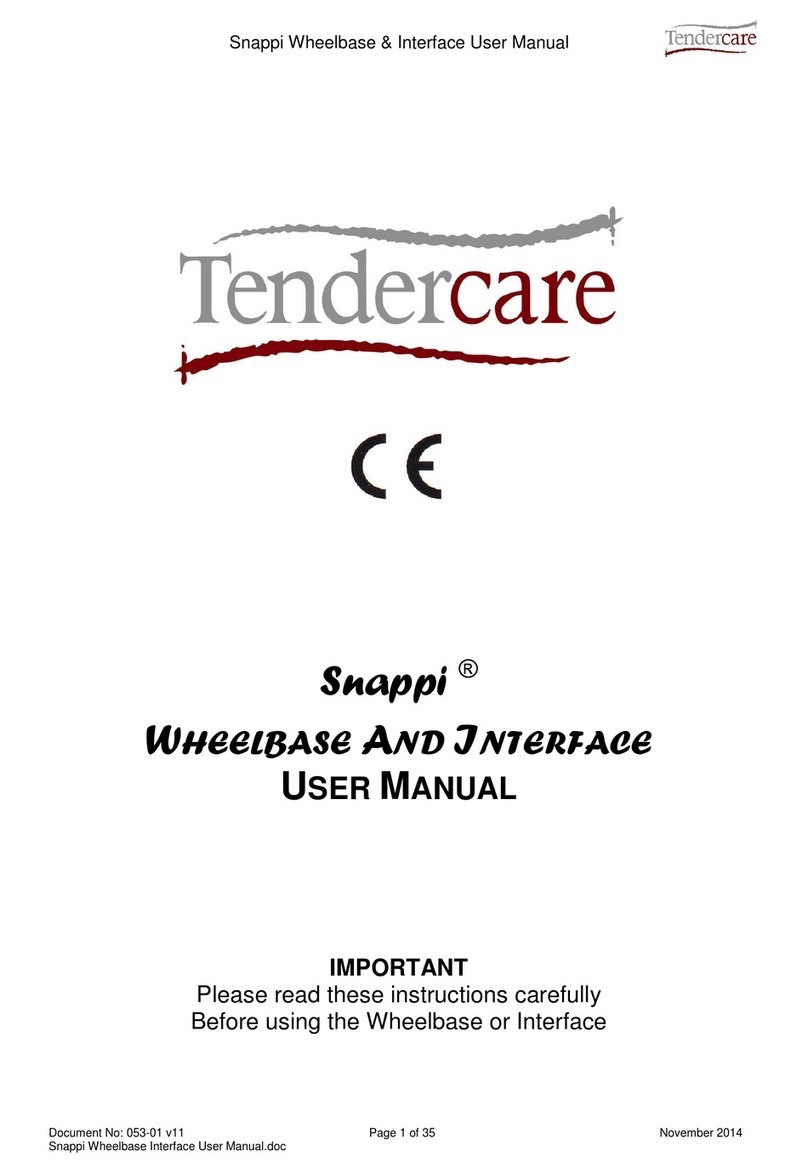
Tendercare
Tendercare Snappi User manual

Tendercare
Tendercare Extra Small Fold-a-Way Spring User manual
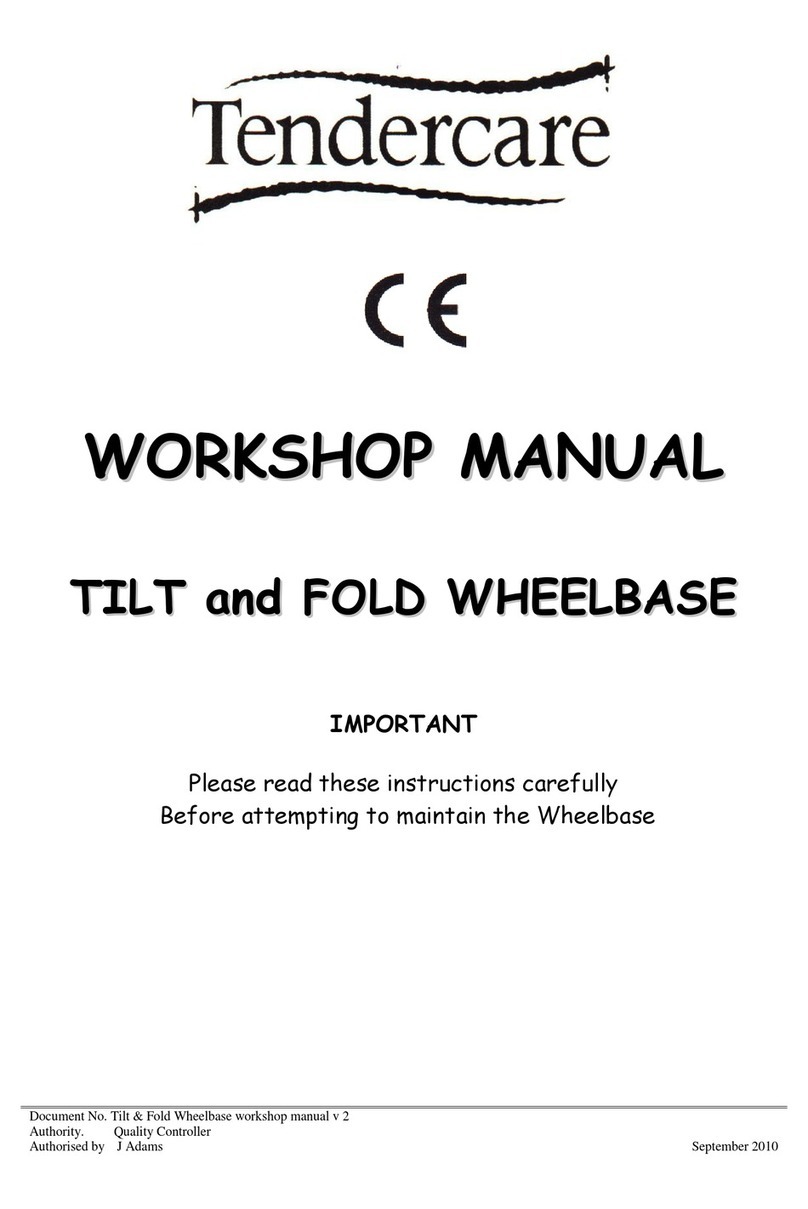
Tendercare
Tendercare TILT and FOLD Instruction manual

Tendercare
Tendercare MINI TILT User manual
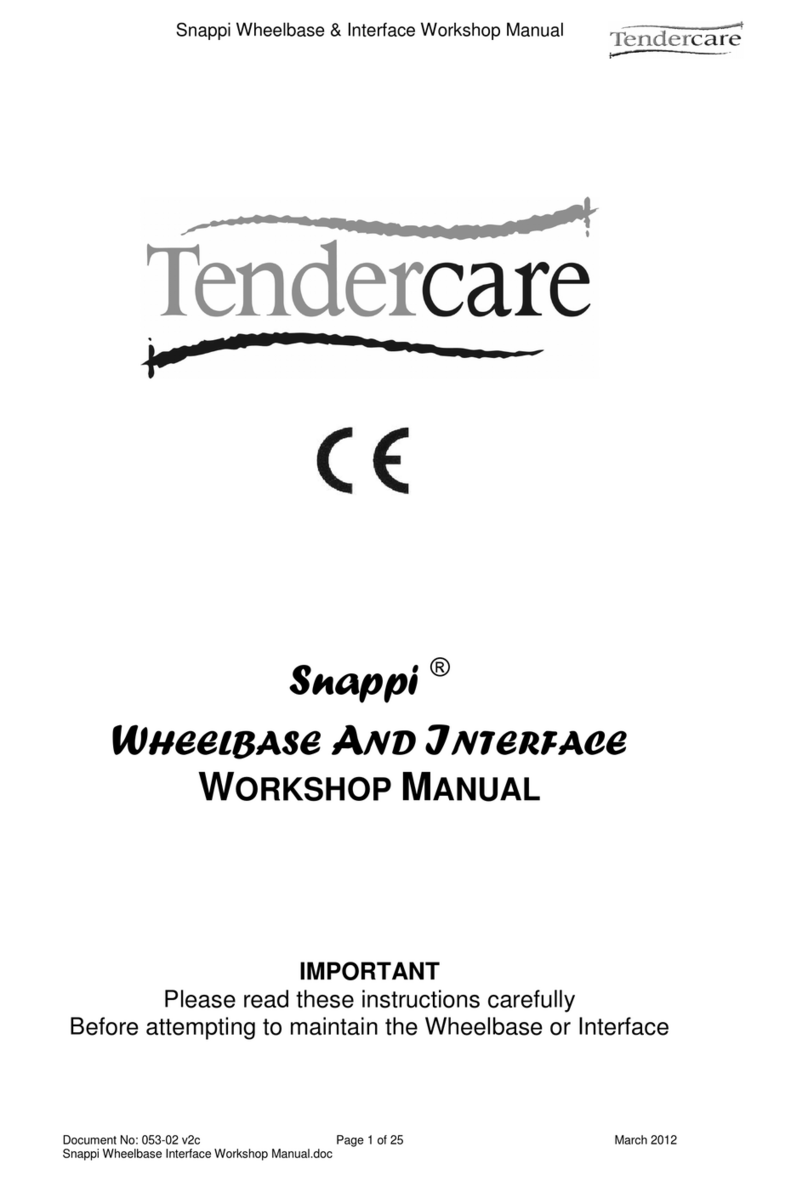
Tendercare
Tendercare Snappi Instruction manual
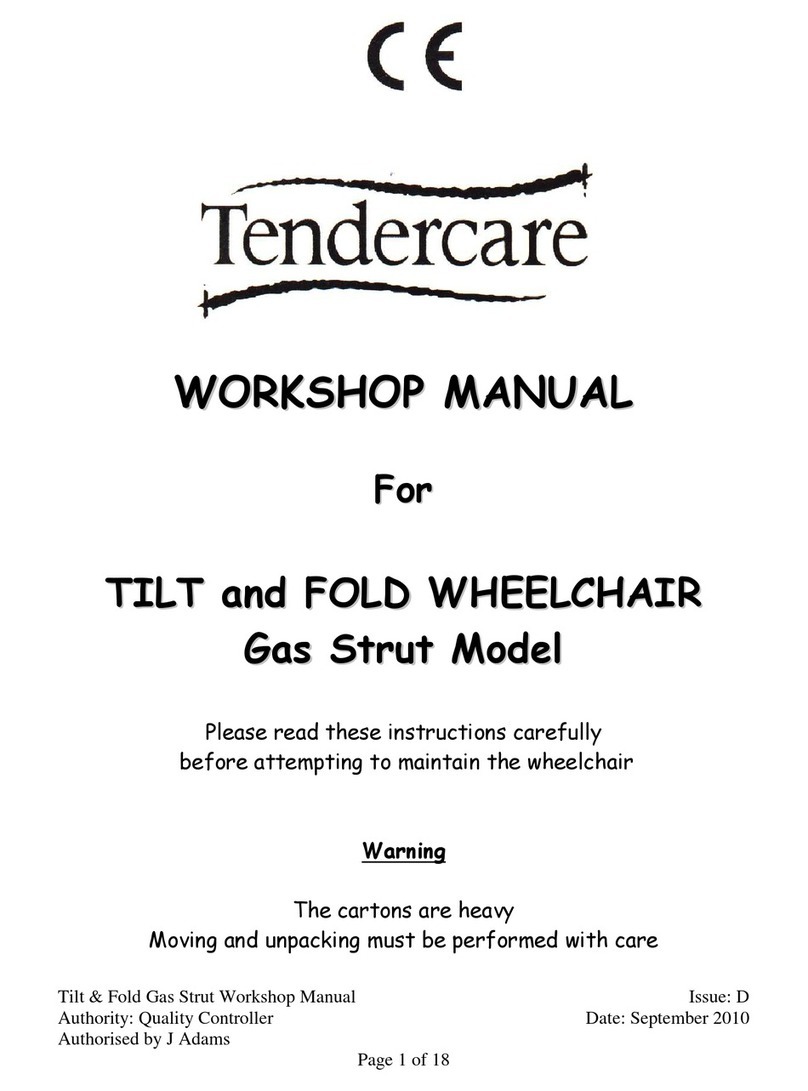
Tendercare
Tendercare GAS STRUT TILT and FOLD Wheelchair Instruction manual
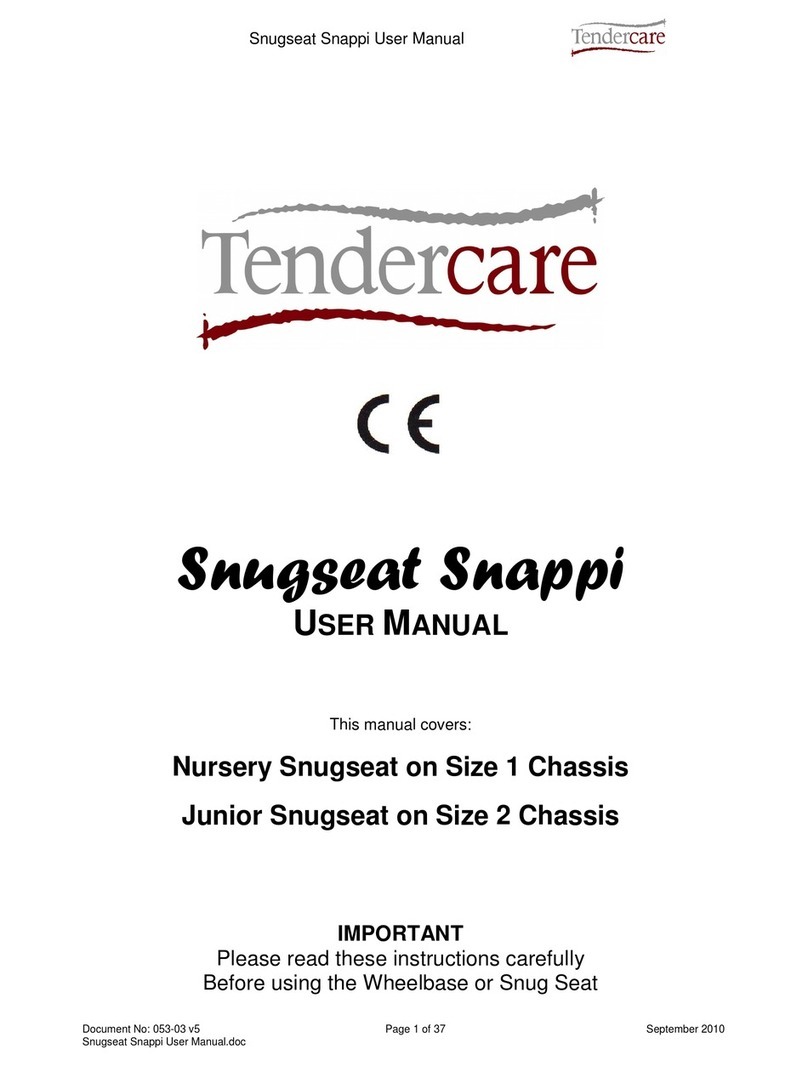
Tendercare
Tendercare Snugseat Snappi User manual

Tendercare
Tendercare MINI TILT Instruction manual
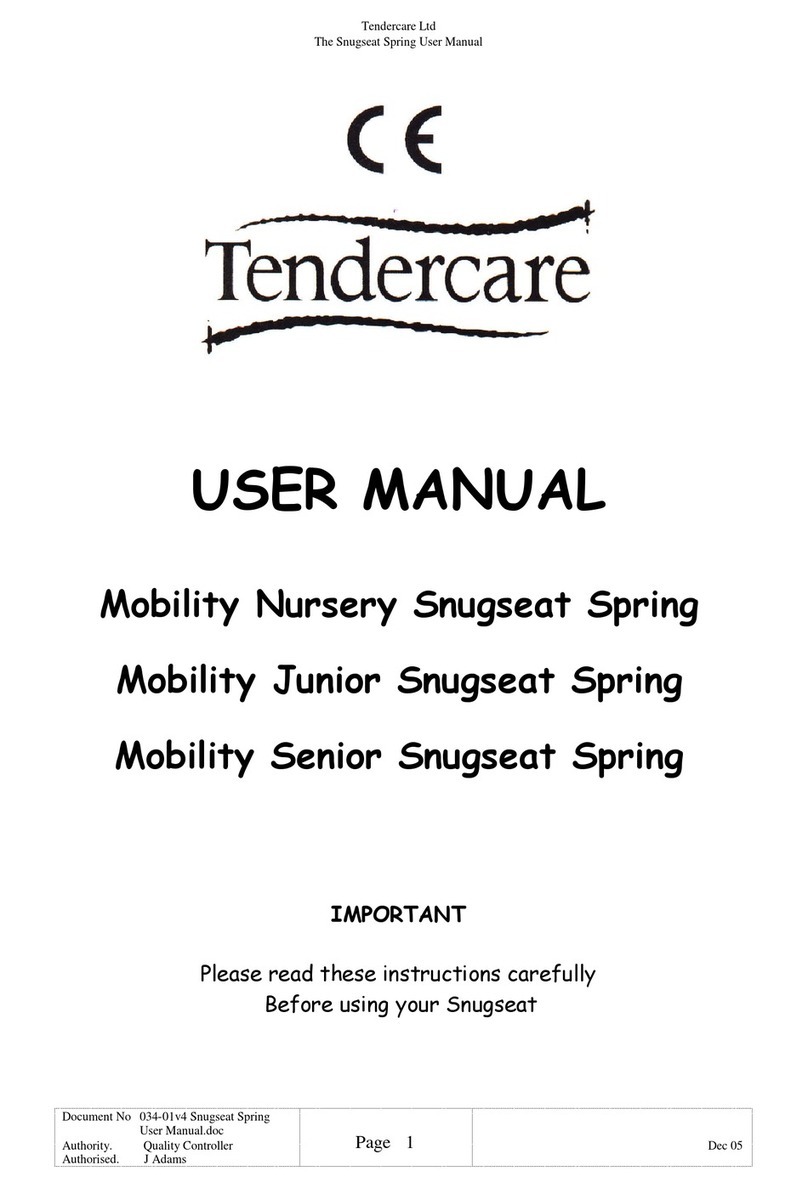
Tendercare
Tendercare Mobility Nursery Snugseat Spring User manual

